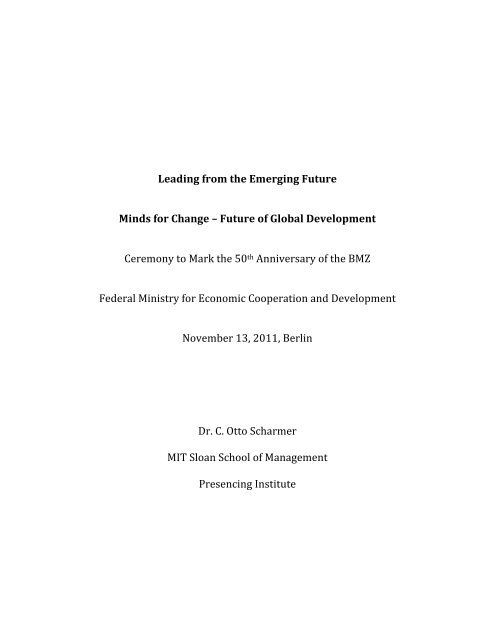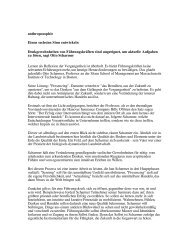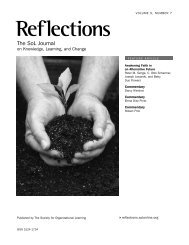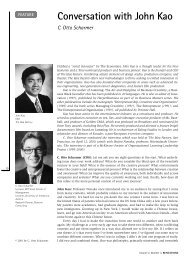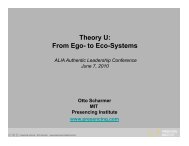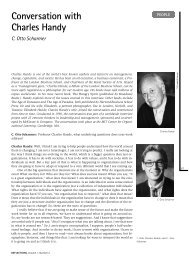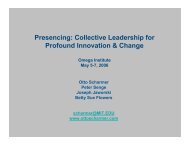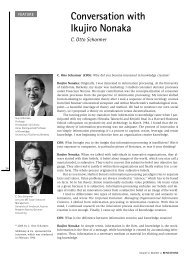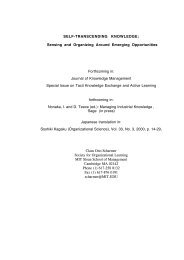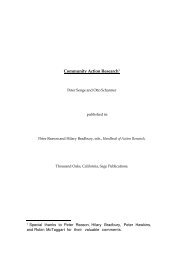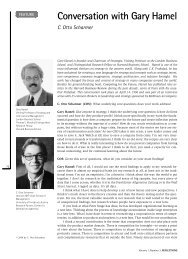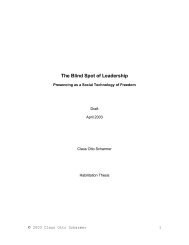Leading from the Emerging Future Minds for Change - Otto Scharmer
Leading from the Emerging Future Minds for Change - Otto Scharmer
Leading from the Emerging Future Minds for Change - Otto Scharmer
You also want an ePaper? Increase the reach of your titles
YUMPU automatically turns print PDFs into web optimized ePapers that Google loves.
<strong>Leading</strong> <strong>from</strong> <strong>the</strong> <strong>Emerging</strong> <strong>Future</strong><br />
<strong>Minds</strong> <strong>for</strong> <strong>Change</strong> – <strong>Future</strong> of Global Development<br />
Ceremony to Mark <strong>the</strong> 50 th Anniversary of <strong>the</strong> BMZ<br />
Federal Ministry <strong>for</strong> Economic Cooperation and Development<br />
November 13, 2011, Berlin<br />
Dr. C. <strong>Otto</strong> <strong>Scharmer</strong><br />
MIT Sloan School of Management<br />
Presencing Institute
Honorable State Secretary, Excellencies,<br />
I would like to start with a quote that articulates a feeling that I have found in many<br />
leadership teams in government, in business, and in NGOs. Speaking in Philadelphia<br />
in 1994, President of <strong>the</strong> Czech Republic Vaclav Havel said: “I think <strong>the</strong>re are good<br />
reasons <strong>for</strong> suggesting that <strong>the</strong> modern age has ended. Today, many things indicate<br />
that we are going through a transitional period, when it seems that something is on<br />
<strong>the</strong> way out and something else is painfully being born. It is as if something were<br />
crumbling, decaying, and exhausting itself – while something else, still indistinct, were<br />
rising <strong>from</strong> <strong>the</strong> rubble.”<br />
What is crumbling, decaying, and exhausting itself today is an old way of solving<br />
problems, of building institutions and societies. And what is seeking to emerge is a<br />
new way of regenerating our social fabric that in many places has fallen apart.<br />
Regardless of <strong>the</strong> culture or sector we come <strong>from</strong>, we all share one characteristic:<br />
we participate in large systems in which we collectively create results that nobody<br />
wants. We collectively create results that nobody wants. Here are three figures that<br />
indicate how we’re destroying some of <strong>the</strong> features of society that we claim to hold<br />
most dear: our planet; our society; and our spirit.<br />
The number 1.5 represents our ecological crisis. Although we have only one planet<br />
Earth, we deplete and degrade our natural capital on a massive scale, using up more<br />
resources every year. We live as if we have more than one planet at our disposal,<br />
using <strong>the</strong> equivalent of 1.5 planets just to meet our current consumption. As a<br />
consequence, we have seen one third of our agricultural land disappear over <strong>the</strong><br />
past 40 years, and we see rapidly falling water tables that bring us on a path<br />
towards food supply crises, food riots, and an expected doubling of food prices by<br />
2030.<br />
The number 2.5 represents our social crisis. Two and a half billion people on our<br />
planet live in poverty. There have been many successes at lifting people out of<br />
poverty, but this number, 2.5, has not changed much over <strong>the</strong> past few decades.<br />
The number 3 represents our inner or spiritual crisis. According to <strong>the</strong> World Health<br />
Organization (WHO), three times as many people die <strong>from</strong> suicide as die <strong>from</strong><br />
homicide or in wars. Although men and women are fighting wars around <strong>the</strong> world,<br />
three times more people kill <strong>the</strong>mselves than kill o<strong>the</strong>rs. The inner crisis also<br />
manifests in many o<strong>the</strong>r <strong>for</strong>ms including rapidly growing figures <strong>for</strong> burn out and<br />
depression that both indicate an increasing gap between our exterior activities and<br />
our interior sources of creativity and presence.<br />
These three dimensions of collectively creating results that nobody wants constitute<br />
<strong>the</strong> most significant institutional and leadership failure of our time.
What did we learn about addressing <strong>the</strong>se issues throughout <strong>the</strong> 20 th century?<br />
What we did in <strong>the</strong> 20 th century is create dedicated singular ministries <strong>for</strong> each of<br />
<strong>the</strong>se problems in government; we created dedicated NGOs <strong>for</strong> each of <strong>the</strong>se issues<br />
in civil society, and we created dedicated university departments and academic<br />
career paths <strong>for</strong> each of <strong>the</strong>se issues. Today we know that this silo type of approach<br />
of one issue at a time isn’t working—on <strong>the</strong> contrary, it seems to be a certain path to<br />
failure.<br />
What sort of leadership will it take to solve <strong>the</strong>m?<br />
With that question in mind, I went to MIT some 15 years ago. Since <strong>the</strong>n I have been<br />
immersed in many large systems change projects and also in research that allowed<br />
me to interview 150 of <strong>the</strong> world’s thought leaders and innovators on profound<br />
innovation and change.<br />
What I learned <strong>from</strong> <strong>the</strong>se years is that <strong>the</strong>re are two fundamentally different<br />
sources of learning. The first is learning <strong>from</strong> <strong>the</strong> past. The second is learning <strong>from</strong><br />
<strong>the</strong> future as it emerges.<br />
All major learning methodologies today reflect on <strong>the</strong> experiences of <strong>the</strong> past,<br />
including those used by Peter Senge, Ed Schein, and Chris Argyris.<br />
But we need more than that. Sometimes <strong>the</strong> past is not very helpful. Sometimes <strong>the</strong><br />
experiences of <strong>the</strong> past are <strong>the</strong>mselves obstacles to coming up with new ideas.<br />
So I set out on a 15-‐year path that led me to <strong>the</strong> conclusion that real innovators<br />
operate using that second type of learning process. They learn <strong>from</strong> <strong>the</strong> future as it<br />
emerges.<br />
The economist Brian Arthur explained to me how to gain access to this second type<br />
of knowing using a three-‐step process. The first step he called observe, observe<br />
observe. What does it mean? It means stop downloading and totally immerse<br />
yourself in <strong>the</strong> places of most potential, in <strong>the</strong> places that matter most to <strong>the</strong><br />
situation you are dealing with.<br />
Second, retreat and reflect, allow <strong>the</strong> inner knowing to emerge. He also said go to <strong>the</strong><br />
places of stillness where knowing comes to <strong>the</strong> surface. Here you share and reflect on<br />
everything that you have learned <strong>from</strong> a deep place of listening, asking “what wants<br />
to emerge here?” and “how does that relate to my and our journey <strong>for</strong>ward? So <strong>the</strong><br />
key question is: how can we become a part of <strong>the</strong> story of <strong>the</strong> future ra<strong>the</strong>r than<br />
holding on to and embodying <strong>the</strong> story of <strong>the</strong> past?”<br />
And third, when a spark or two appears, act in an instant. Explore <strong>the</strong> future by<br />
doing. Develop a prototype. A prototype explores <strong>the</strong> future by doing something
small and quickly that generates feedback <strong>from</strong> all <strong>the</strong> key stakeholders and allows<br />
you to evolve <strong>the</strong> idea.<br />
But that process only works if you attend to a deeper process of leadership. Here is<br />
how one of my interviewees talked about it.<br />
The late CEO of Hanover insurance, Bill O’Brien, summarized his experience of<br />
leading trans<strong>for</strong>mational change as follows: The success of an intervention depends<br />
on <strong>the</strong> interior condition of <strong>the</strong> intervenor. The success of what I do as a leader<br />
depends on <strong>the</strong> inner place <strong>from</strong> which I operate.<br />
So what we learned is that what counts is not <strong>the</strong> What and not <strong>the</strong> How but <strong>the</strong><br />
Who — <strong>the</strong> inner place <strong>from</strong> which we operate.<br />
Five Principles of Presencing<br />
Let me now summarize <strong>the</strong> deeper framework of institutional innovation and<br />
change with a few core points.<br />
The essence of this approach can be summarized with a single sentence: <strong>the</strong> quality<br />
of our results in a system is a function of <strong>the</strong> awareness <strong>from</strong> which <strong>the</strong> people in that<br />
system operate. The essence of Theory U is not: I think <strong>the</strong>re<strong>for</strong>e I am. It is: “I attend<br />
this way, <strong>the</strong>re<strong>for</strong>e it emerges that way.”<br />
The following five points apply to how we can shift that inner place of operating.<br />
(1) First, we have to apply <strong>the</strong> processes of observe observe; retreat and reflect;<br />
and act in an instant through prototyping.<br />
(2) Second, to make this work in <strong>the</strong> context of institutions, we have to apply a<br />
new leadership technology. The core of this new leadership technology<br />
requires tuning three instruments: <strong>the</strong> open mind, <strong>the</strong> open heart, and <strong>the</strong><br />
open will. The open mind is <strong>the</strong> capacity to suspend old habits of thought.<br />
The open heart is <strong>the</strong> capacity to empathize, to see a situation through <strong>the</strong><br />
eyes of someone else. And <strong>the</strong> open will is <strong>the</strong> capacity to let go of old ways of<br />
doing things and accept new ones. I call this “letting go and letting come.”<br />
(3) At <strong>the</strong> source of this new leadership technology are <strong>the</strong> two root questions of<br />
creativity: Who is my Self? and What is my Work? And as you can see, <strong>the</strong> Self<br />
is not <strong>the</strong> small “s” self, <strong>the</strong> ego, but <strong>the</strong> capital “S” Self, my highest future<br />
possibility. And <strong>the</strong> work is not <strong>the</strong> small “w” work that is my job, but <strong>the</strong><br />
capital “W” Work, which is my sense of purpose or calling. It’s what I am here<br />
on this earth to do.<br />
(4) Why is this <strong>the</strong> road less traveled? Why is it that most people are aware of<br />
this deeper process and yet it rarely happens in <strong>the</strong> context of our larger
VoJ<br />
VoC<br />
VoF<br />
systems? The answer, I believe, is that <strong>the</strong> moment we commit ourselves to<br />
going on this journey we encounter three enemies: <strong>the</strong> voice of judgment<br />
(VoJ: shutting down <strong>the</strong> open mind), <strong>the</strong> voice of cynicism (VoC: shutting<br />
down <strong>the</strong> open heart), and <strong>the</strong> voice of fear (VoF: shutting down <strong>the</strong> open<br />
will).<br />
Downloading<br />
past patterns<br />
suspending<br />
Seeing<br />
with fresh eyes<br />
redirecting<br />
Sensing<br />
<strong>from</strong> <strong>the</strong> field<br />
letting go<br />
Theory U<br />
Open<br />
Mind<br />
Open<br />
Heart<br />
Open<br />
Will<br />
Presencing<br />
connecting to Source<br />
Who is my Self?<br />
What is my Work?<br />
Figure 1: Theory U: <strong>Leading</strong> <strong>from</strong> <strong>the</strong> <strong>Emerging</strong> <strong>Future</strong><br />
Per<strong>for</strong>ming by<br />
operating <strong>from</strong> <strong>the</strong> whole<br />
embodying<br />
Prototyping <strong>the</strong> new by<br />
linking head, heart, hand<br />
enacting<br />
Crystallizing<br />
vision and intention<br />
letting come<br />
(5) Social reality emerges <strong>from</strong> <strong>the</strong> interplay of two different social fields. The first<br />
field is about <strong>the</strong> coming into being of <strong>the</strong> new. This field works through <strong>the</strong><br />
opening of <strong>the</strong> mind, <strong>the</strong> heart, and <strong>the</strong> will. We call this <strong>the</strong> cycle of<br />
presencing. But everyone who works in real institutions and systems knows<br />
that <strong>the</strong>re is ano<strong>the</strong>r field out <strong>the</strong>re. That field is characterized by getting<br />
stuck with <strong>the</strong> idea of One Truth ra<strong>the</strong>r than operating with an Open Mind,<br />
getting stuck in one collective Us vs. Them temperament ra<strong>the</strong>r than<br />
operating with an Open Heart, and getting stuck or frozen in one rigid<br />
identity or intention ra<strong>the</strong>r than operating with an Open Will.<br />
What do we call social systems that show <strong>the</strong>se three characteristics: stuck in one<br />
Truth, one Us, one Will? Fundamentalist. Fundamentalism is <strong>the</strong> result of closing<br />
down your mind, heart, and will. I call this second field <strong>the</strong> cycle of “absencing.”
The cycle of absencing unfolds through blinding and denial ra<strong>the</strong>r than seeing;<br />
entrenching and desensing ra<strong>the</strong>r than sensing; holding-‐on instead of letting-‐go. By<br />
doing <strong>the</strong>se things, we create an illusionary map of reality that results in killing <strong>the</strong><br />
new instead of birthing and co-‐creating it.<br />
SOCIAL PATHOLOGY!<br />
Economies of Destruction!<br />
SOCIAL EMERGENCE!<br />
Economies of Creation!<br />
© 2011 <strong>Otto</strong> <strong>Scharmer</strong><br />
VoJ<br />
VoC<br />
VoF<br />
DOWNLOADING<br />
suspending<br />
SEEING<br />
redirecting<br />
holding on<br />
DE-SENSING<br />
entrenching<br />
DENYING<br />
blinding<br />
DOWNLOADING<br />
SENSING<br />
letting go<br />
ABSENCING<br />
STUCK IN<br />
ONE SELF/WILL<br />
STUCK IN<br />
ONE SKIN<br />
(US VS. THEM)<br />
STUCK IN<br />
ONE TRUTH/VIEW<br />
OPEN<br />
MIND<br />
OPEN<br />
HEART<br />
OPEN<br />
WILL<br />
PRESENCING<br />
manipulating<br />
PERFORMING<br />
embodying<br />
PROTOTYPING<br />
enacting<br />
CRYSTALLIZING<br />
letting come<br />
DELUDING<br />
abusing<br />
ABORTING<br />
disembodying<br />
DESTROYING<br />
Figure 2: The social spaces of emergence (presencing) and pathology (absencing)<br />
What’s so interesting today is that our complex institutions include both of <strong>the</strong>se<br />
fields, <strong>the</strong> space of social emergence and <strong>the</strong> space of social pathology. Many of us<br />
individually and in small groups operate in <strong>the</strong> yellow space of presencing. Yet,<br />
collectively, we tend to operate in <strong>the</strong> blue space of absencing as evidenced in <strong>the</strong><br />
widening of <strong>the</strong> three divides discussed earlier.<br />
So what can we do to bridge <strong>the</strong> three divides and streng<strong>the</strong>n <strong>the</strong> capacity of<br />
systems to move <strong>from</strong> <strong>the</strong> blue (space of absencing) to <strong>the</strong> yellow (space ,of<br />
presencing)?<br />
This story <strong>from</strong> Namibia is a good illustration of how to bridge <strong>the</strong>se divides.
I was invited by <strong>the</strong> Ministry of Health and Social Services in Namibia to facilitate a<br />
workshop with <strong>the</strong> national cabinet. The ministers and deputy ministers explained<br />
<strong>the</strong>ir circumstances to me as follows: They said, “Look, here is what we face. We<br />
have all <strong>the</strong>se long-‐term and short-‐term planning processes, and yet we know that<br />
our governmental system and <strong>the</strong> services that we deliver are largely disconnected<br />
<strong>from</strong> <strong>the</strong> real needs in <strong>the</strong> communities. We also have a disconnect between <strong>the</strong><br />
political leadership and <strong>the</strong> civil servants. And <strong>the</strong> third problem we have is that we<br />
work in isolated silos among all our Ministries that are replicated within our<br />
Ministries as well. What can we do?”<br />
First, we helped <strong>the</strong> Ministry of Health and Social Services to assess <strong>the</strong> problems in<br />
<strong>the</strong>ir own system. They identified a number of bottlenecks. After that, <strong>the</strong>y<br />
requested a leadership capacity-‐building program <strong>for</strong> <strong>the</strong> team at <strong>the</strong> top, which our<br />
team provided as a quarterly leadership development <strong>for</strong>um. We also facilitated a<br />
multi-‐stakeholder project that focuses on maternal health.<br />
In <strong>the</strong> “sensing phase” of <strong>the</strong> maternal health project, <strong>the</strong> project team went into <strong>the</strong><br />
field to experience <strong>the</strong> system firsthand by walking in <strong>the</strong> shoes of all <strong>the</strong> key<br />
stakeholders, including <strong>the</strong> frontline nurses and remote patients. They came back<br />
and shared what <strong>the</strong>y learned with <strong>the</strong> o<strong>the</strong>rs.<br />
Then <strong>the</strong> team moved into <strong>the</strong> “presencing phase”. In a retreat, <strong>the</strong>y reflected deeply<br />
on everything <strong>the</strong>y had learned in <strong>the</strong> sensing phase and how it related to <strong>the</strong>ir own<br />
journey. They connected with <strong>the</strong> deeper personal contexts and stories that each<br />
person brings. They also realized how much <strong>the</strong>ir own story was interwoven with<br />
<strong>the</strong> evolutionary challenges of <strong>the</strong>ir health system. In <strong>the</strong> concluding part of <strong>the</strong><br />
retreat <strong>the</strong>y developed five prototyping initiatives that focused on three main areas:<br />
access, capacity building, and user mindsets.<br />
They tested and developed <strong>the</strong>se prototyping ideas in one region. Then <strong>the</strong>y took<br />
<strong>the</strong> best ideas that came out of that first round of prototyping work and applied<br />
<strong>the</strong>m to o<strong>the</strong>r regions in <strong>the</strong> country. To date, half <strong>the</strong> regions in <strong>the</strong> country are in<br />
<strong>the</strong> process of implementing <strong>the</strong>se institutional and practical innovations, including<br />
<strong>the</strong> creation of a cross-‐functional and cross-‐organizational innovation hub called a<br />
“regional delivery unit” that brings toge<strong>the</strong>r key decisionmakers every week in<br />
order to support fast-‐cycle prototyping and learning.<br />
What we discovered toge<strong>the</strong>r in Namibia was that <strong>the</strong> leaders of <strong>the</strong> system needed<br />
to go on a journey of trans<strong>for</strong>ming <strong>the</strong>ir connections with each o<strong>the</strong>r, with <strong>the</strong> larger<br />
system, and with <strong>the</strong>mselves.<br />
The three divides that mark our current global crisis are an expression of a required<br />
next step in evolving our institutions of government, business, and civil society.<br />
In terms of our economic development, we have moved <strong>from</strong> a 1.0 stage of<br />
centralized single-‐sector economies to a 2.0 stage that gave rise to <strong>the</strong> private sector
and a laissez-‐faire type of market economy. We <strong>the</strong>n moved to a 3.0 stage¸ a social<br />
market economy that is based on <strong>the</strong> interplay of three conflicting sectors—<br />
business, government, and civil society—that are largely organized around special<br />
interests. I see our current global crisis as a call to continue our societal evolution to<br />
a 4.0 stage that would move us <strong>from</strong> conflict to co-‐creation among <strong>the</strong> sectors, and<br />
that would allow us to address <strong>the</strong> three divides by innovating at <strong>the</strong> scale of <strong>the</strong><br />
whole system.<br />
We saw in Namibia that this journey requires people to change <strong>the</strong> inner place <strong>from</strong><br />
which <strong>the</strong>y operate. They need to move <strong>from</strong> an egosystem awareness to an<br />
ecosystem awareness. We learned in Namibia and o<strong>the</strong>r places (a) that this change<br />
is possible and (b) that it requires a supporting infrastructure.<br />
What inspires me in this Forum is that we, as a community of leaders, have <strong>the</strong><br />
opportunity to identify <strong>the</strong> seeds of <strong>the</strong> future that reside in some of <strong>the</strong> stories that<br />
we are hearing today, and bring <strong>the</strong>m into <strong>the</strong> mainstream by applying <strong>the</strong>m to <strong>the</strong><br />
three global divides of our time. Thank you very much.


